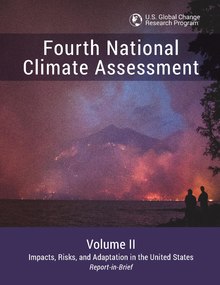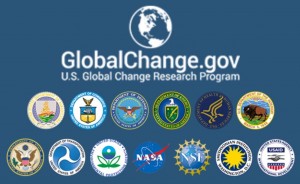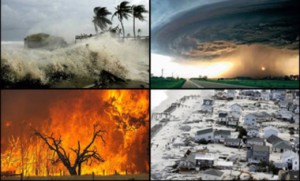 It’s no surprise that the latest U.S. climate assessment report dropped on Black Friday. Can you think of a better day to bury a report that presents, quite literally, an inconvenient truth?
It’s no surprise that the latest U.S. climate assessment report dropped on Black Friday. Can you think of a better day to bury a report that presents, quite literally, an inconvenient truth?
The report is volume 2 (vol. 1 was released more than a year ago) of the fourth congressionally mandated National Climate Assessment—a quadrennial (since 1989) effort to integrate climate-related research conducted by 13 federal agencies, including NASA, the Department of Defense, the EPA, and the National Science Foundation.
The politics of climate change, throughout the lifetime of this program, have become increasingly complicated. The program’s findings, on the other hand, aren’t complicated at all. They have consistently shown that anthropogenic (human caused) climate change is real. They’ve shown that the widespread, industrialized combustion of fossil fuels has led to an increase of atmospheric carbon that, when compared to air bubbles found in ice-core samples taken from around the world, is exponentially higher than anything our planet has experienced in hundreds of thousands of years. The research shows, definitively, that this carbon traps terrestrial heat—in other words, solar radiation passes through the atmosphere as it’s always done, but when it’s reflected off, or absorbed then released by the land and seas, its wavelength is altered to a band that can’t pass through the atmosphere. At sustainable levels of carbon in our skies, planetary temperatures are regulated, with excess heat bleeding off into space. At our present carbon levels, we’ve effectively placed a blanket around the earth.
of fossil fuels has led to an increase of atmospheric carbon that, when compared to air bubbles found in ice-core samples taken from around the world, is exponentially higher than anything our planet has experienced in hundreds of thousands of years. The research shows, definitively, that this carbon traps terrestrial heat—in other words, solar radiation passes through the atmosphere as it’s always done, but when it’s reflected off, or absorbed then released by the land and seas, its wavelength is altered to a band that can’t pass through the atmosphere. At sustainable levels of carbon in our skies, planetary temperatures are regulated, with excess heat bleeding off into space. At our present carbon levels, we’ve effectively placed a blanket around the earth.
 Since the first Climate Assessment Report was completed in 1990, the interagency panel has warned that increasing global temperatures will lead to drought, wildfires, more frequent and more destructive oceanic storms, coastal flooding, mass migrations of climate refugees, conflicts over disappearing land and resources, and increasing risks to every foundation of civilization itself.
Since the first Climate Assessment Report was completed in 1990, the interagency panel has warned that increasing global temperatures will lead to drought, wildfires, more frequent and more destructive oceanic storms, coastal flooding, mass migrations of climate refugees, conflicts over disappearing land and resources, and increasing risks to every foundation of civilization itself.
Although these warnings have been taken seriously by a plurality of Americans and by most of the world, the politics as I’ve said are complicated, and climate deniers have (here at least) remained influential. So in the U.S. very little action has been taken. Presently, and Friday’s report notwithstanding, the administration’s stance toward climate change (and the mitigation thereof) is actively hostile. Political appointees and leadership at those aforementioned agencies seem to take climate denial and regulatory rollback as their prime mandates. And Trump himself, beginning with the his withdrawal from the Paris Climate Treaty, has led the way.
The report released on Friday is the most dire warning yet. Its driving conclusions: carbon levels are increasing much more quickly than previously forecast, impacts of a heating planet are already upon us, and it’s almost too late to do anything about it.
On that last point—only a concerted, unified effort by every government on earth could now cut back carbon pollution to the level mandated by the Paris accord. And even at that level the world will continue to warm, albeit at a slower pace.
Such an effort seems vanishingly unlikely. U.S. leadership in this realm has disappeared. China is embracing renewable energy but still burns more fossil fuels than any other country, and will continue to do so for the foreseeable future. Other emerging economies express concern, but are understandably reluctant to curtail their own growth for the sake of a seemingly unengaged First World.
Even in Europe the outlook is bleak, despite the EU’s lead on renewables and climate initiatives. France itself gave us the Paris treaty, but is as we speak roiled by the so-called “yellow vest” protests, a response by drivers and low-income workers to onerous fuel taxes designed to drive down carbon consumption. One protester was just quoted as saying that the taxes were imposed by those concerned with the end of the world. “We’re just worried about getting through the end of the month,” he said. It’s a point that’s hard to contest.
France itself gave us the Paris treaty, but is as we speak roiled by the so-called “yellow vest” protests, a response by drivers and low-income workers to onerous fuel taxes designed to drive down carbon consumption. One protester was just quoted as saying that the taxes were imposed by those concerned with the end of the world. “We’re just worried about getting through the end of the month,” he said. It’s a point that’s hard to contest.
More than anything, though, it’s inertia and intransigence that almost guarantee inaction. Human institutions—human nature itself—aren’t equipped to engineer the epochal pivot that’s needed to mitigate climate change. Nearly everything about the ways we live, work, travel, and grow would be impacted—in most cases, drastically. We’re hard-wired to resist that kind of change. And consider this: such change could not (arguably) happen absent American leadership, and that leadership would have to begin immediately; 2020 would be too late. This would require, at the starting block, a tacit admission by Donald Trump that he’s been wrong all along on this subject, and that Barack Obama, among others, was right. Such an admission just might be the unlikeliest scenario of all these.
So what’s left? There’s this: climate change isn’t coming. It’s here. Global average temperatures have been and will continue to rise. The forecasted droughts, storms, fires, and flooding are already upon us. Global warming and everything that comes with it is the reality we’re living.
The watchword now is adaptation. We as a species have to come to terms with a world and an environment that is frighteningly different from the one we evolved to thrive in. We need to adapt to a different climate, different landscapes and coastlines, an altered food chain, and vastly divergent modes of civilization.
There’s a glimmer of hope there—homo sapiens is a vigorously adaptive species. We’ve flourished in environments ranging from the tropics to the arctic circle and everything in between. We have reason to believe that climate adaption is a viable strategy.
It had better be. It’s becoming more and more likely it’s the only one we’ve got.